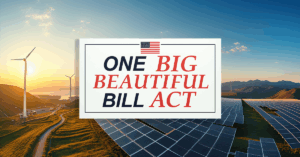Financial forecasting is crucial for cleantech companies to manage their finances effectively, and we usually consider two main aspects for the shorter and longer-term:
• Cash flow forecasting or budgeting is an exercise done periodically to estimate and plan cash flows over a specific period and calculate waterfall distributions to debt, investors, and reserves
• Project Financial Modeling is a broader, longer-term process incorporating cash flow forecasting. It predicts revenues, expenses, profits, assets, liabilities, and equity based on historical data, market trends, industry analysis, and management expectations. The goal is to analyze the risks and rewards of investing in long-term infrastructure projects.
In this blog, we will walk through the ins and outs of cash flow forecasting or budgeting to meet the requirements for waterfall distributions. There are clear steps to follow that will make the process more predictable for your business:
Looking for accounting support that’s uniquely suited to renewable energy companies? Click here to visit our page!
1. Review the agreements related to the project
The importance of specific agreements can vary depending on the context and the parties involved in a waterfall distribution structure for your cleantech project. However, you should pay close attention to:
• Power Purchase Agreement (PPA): This is the contractual agreement between the producer and purchaser. The PPA sets out the predetermined price, period, and terms when the purchaser agrees to buy energy. This ensures a stable revenue stream for the project, reducing financial risk and promoting the growth of clean energy generation.
• Loan Agreement: This document outlines the overall structure, rules, and procedures governing the distribution of funds or cash flows in a waterfall arrangement, including priority, timing, and the legal framework.
• Leasing Agreement: If your cleantech company enters into leasing arrangements for equipment, facilities, or other assets, the leasing agreement establishes the terms, rights, and obligations related to the lease, including payment terms and any potential impact on cash flows or distributions.
• Operating Agreement: If your company is an LLC, this document governs the internal operations, management, and distribution of profits or cash flows among the members or owners of the LLC. The operating agreement may also contain provisions related to waterfall distribution.
• Operation and Maintenance and other Vendor Contracts: These agreements with suppliers or service providers outline the terms of engagement, including pricing, delivery schedules, payment terms, and any potential impact on cash flows. While vendor contracts may not directly govern the waterfall distribution structure, they can indirectly influence cash flows and, consequently, distributions.
2. Forecast cash revenues
Accurately forecasting revenues is an essential part of developing your cash flow projection. It’s vital to understand the rates in the relevant PPA contracts and hear from your asset management and project finance teams regarding the power generation forecast applicable for the next 12 months. You should also consider market demand, competition, regulatory changes, and customer behavior. It’s important to be realistic and consider potential risks and uncertainties.
3. Forecast cash operating expenses
Make sure to review any contract amendments or annual provisions in the original agreements. Identify and estimate your company’s expenses. This includes costs related to operations, maintenance, insurance premiums, asset management fees, telecommunication costs, consultant costs, and any other relevant expenses. Reviewing historical data and industry benchmarks can also help you accurately estimate future expenses.
4. Build the waterfall based on the agreed priority cascade
Waterfall distribution must be built according to the information in your various agreements and projected cash flow. It will also depend on the financing type, e.g., sale and leaseback, partnership flip, or inverted lease because each financing arrangement comes with its own set of rights, priorities, and expectations. The waterfall structure is designed to allocate funds or returns in a manner that reflects these factors and meets the requirements and preferences of the various stakeholders involved. It is crucial to carefully consider and define the distribution priorities and rules based on the specific terms of each financing arrangement to ensure fairness and alignment among all parties.
5. Incorporate schedules for financing and cash reserves
To ensure you can meet your funding needs while retaining sufficient cash reserves to support ongoing operations, your business needs to integrate specific timelines and plans for different financial activities.
• Financing schedules help you plan for capital raises, debt issuances, or other funding sources required to support the business’s operations or growth. The schedules identify when and how the company intends to secure additional funding so that you have the necessary financial resources available when needed.
• Cash reserves are funds set aside to provide a financial cushion for unforeseen events, operational needs, or strategic initiatives. Establishing a plan for maintaining adequate levels of cash on hand and regularly reviewing and adjusting those levels based on the company’s financial requirements and risk tolerance are essential to your projects’ success.
By incorporating these schedules, you’ll be able to proactively manage financial needs, optimize your funding strategy, and ensure that you have sufficient liquidity to meet your obligations and pursue growth opportunities.
6. Calculate the DSCR
Debt Service Coverage Ratio (DSCR) is the metric banks use to evaluate the ability of your cleantech company to cover debt repayment obligations from operating income.
DSCR is calculated by dividing the net operating income (total revenue from operations minus expenses and excluding interest and taxes) by the total debt service (interest expense plus principal repayment). The resulting ratio represents the number of times the company’s operating income can cover its debt obligations. A DSCR greater than 1 indicates that the company generates sufficient income to cover its debt payments, while a DSCR less than 1 suggests that the company may face challenges meeting its debt obligations.
Lenders and investors often use the DSCR as a key financial indicator to assess the creditworthiness of and risk associated with financing a company.
7. Regularly review and reconcile your bank balances and the running cash flow
Make sure to match historical data with the actual cash inflows and outflows and validate current bank balances. You should also review your actual cash flow against your forecasted cash flow. Monitoring variances will help you identify any potential cash flow gaps and take appropriate actions.
8. Prepare the draw request
A waterfall draw request typically includes the following components:
• Draw amount: The requested funds the entity or project seeks from the available capital pool or funding source. It should be clearly specified and supported by the necessary documentation or justifications.
• Purpose of the draw: A detailed explanation of why the funds are being requested, including the specific purpose or use for which the funds will be utilized. This helps the funding source understand the intended use of the funds and evaluate the validity of the request.
• Supporting documentation: Depending on the nature of the draw, various supporting documents may be required. These could include invoices, receipts, contracts, progress reports, or any other relevant evidence substantiating the need for the requested funds.
• Compliance with draw requirements: The draw request should demonstrate compliance with any specific requirements or conditions outlined in the funding agreement or the waterfall distribution structure. This may involve meeting specific performance milestones, satisfying reporting obligations, or adhering to predetermined timelines.
• Timing and frequency: Specify the timing of the draw request, including the desired date or period when the funds are needed. Additionally, if there are limitations or guidelines on the frequency of draw requests, ensure compliance with those parameters.
• Contact information: Include the contact details of the individual or department responsible for the draw request.
It’s important to note that the specific requirements for a waterfall draw request can vary depending on the funding source, the funding agreement, and the industry or project involved.
Cash flow forecasting and budgeting should be an ongoing process. Cleantech investments are subject to strict compliance, and some financial institutions require periodic cash calculations for their waterfall cash draw requests. The budgets and calculations should be revisited at least annually for amendments, escalations, or updates.
Scrubbed can help
Handling tax, real estate accounting solutions, accounting, and finance issues for a cleantech organization can be challenging.
Scrubbed works with diverse clients from solar to biomass and across clean tech. We understand the importance of staying up-to-date with regulations that govern everything from Special Purpose Vehicles (SPVs) to climate change mitigation efforts. We can help you maximize investment and production credits to support your growth. By partnering with Scrubbed, you gain a team with the depth, insight, and experience to scale as your needs grow.
Contact us for a free consultation today.





